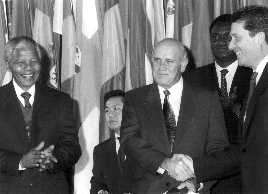Chapter 1
Preface
Pages 1-2-3
-
Chapter 2
Lessons
Pages 4-5-6
-
Chapter 3
Values
Pages 7-8-9
-
Chapter 4
Anger
Pages 10-11-12
-
Chapter 5
Action
Pages 13-14-15
-
Chapter 6
Affiliation
Pages 16-17-18
-
Chapter 7
Integration
Pages 19-20-21
-
Chapter 8
World-Historic Consciousness
Pages 22-23-24-25-26
-
Chapter 9
Universality
Page 27
-
Chapter 10
Root Causes
Pages 28-29-30
-
Chapter 11
The New Psychology
Pages 31-32-33
-
Acknowledge-
ments
Page 37
In the earlier period, the world was stuck in the "quagmire of anti-communism", to quote the Reverend Martin Luther King. The world was held hostage by the Cold War and the nuclear arms race which threatened to destroy the world from one minute to another demanding the constant attention of peace activists.
With the end of the Cold War, peace activists have been able to refocus their attention more on the root causes of the war system. Working in thousands of non-governmental organizations (NGO's) around the world, they are addressing the political and economic injustices which, since the beginning of history, have led to war. [note added later: see http://decade-culture-of-peace.org.]
The United Nations and its specialized agencies have emerged from the paralysis of the Cold War and begun to accomplish the tasks for which they were designed fifty years ago "to save succeeding generations from the scourge of war."
As a result, the nation-state, long the monopolizer of organized violence and the bastion of the war system, has begun to yield power on both flanks - to the United Nations on a global level and to NGO's on a local level.
We can now see emerging the outlines of a global movement to replace the culture of war with a culture of peace. Disarmament remains essential to this movement, but it also links up with the struggles for democracy, human rights and for equitable, endogenous, sustainable development.
The first edition of this book focussed on the Cold War and on peace activists from one of the two super-powers involved, the U.S. Regrettably, an equal emphasis was not given to Soviet peace activists who, at that time, played an important role in ensuring that their country's dramatic transition took place without recourse to the terrible military force that was at their disposal.
Now that the attention of the peace movement has become truly global in scope, it is appropriate that this book should be expanded to include the perspective of a great peace activist from another part of the world: Nelson Mandela of South Africa.
 |
Awarding of the Houphouet-Boigny Prize for Peace to Nelson Mandela and Frederick DeKlerk at UNESCO, 3 February 1992 |
The stages of consciousness development illustrated by Nelson Mandela in his autobiography, Long Walk to Freedom, are so similar to those described by American peace activists, that it makes a strong case for the universality of these processes - at least for the present moment of history. This is as it should be if we believe with Mandela and others that we are on the verge of a single global civilization and a global movement for a culture of peace.
As Mandela puts it, the changes in travel, communication and mass media have accelerated and now changes occur so fast it is difficult to keep up with them:
"What struck me so forcefully was how small the planet had become during my decades in prison; it was amazing to me that a teenage Innuit living at the roof of the world could watch the release of a political prisoner on the Southern tip of Africa. Television had shrunk the world; and had in the process become a great weapon for eradicating ignorance and promoting democracy."
Like other activists described in first edition of this book, Nelson Mandela is very explicit about the importance for him of the basic values of freedom, integrity and democracy received from his extended family, the tribe and culture. Throughout the most difficult years of his imprisonment, he shared a sense of purpose with his colleagues and resisted the attempts of the prison authorities "to exploit every weakness, demolish every initiative, negate all signs of individuality - all with the idea of stamping out that spark that makes each of us human and each of us who we are."
(continued on next page)
 |
 |
 |